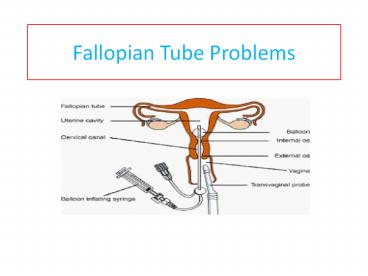fallopian tube problems 7 july17 - PowerPoint PPT Presentation
Title:
fallopian tube problems 7 july17
Description:
The human oviduct, also known as the fallopian tube, is an essential component of the normal reproductive process – PowerPoint PPT presentation
Number of Views:49
Title: fallopian tube problems 7 july17
1
Fallopian Tube Problems
2
Description
- The human oviduct, also known as the fallopian
tube, is an essential component of the normal
reproductive process. The tube, which connects
the peritoneal space to the endometrial cavity,
captures the egg after ovulation and transports
the sperm from the uterus to the fertilization
site in the ampulla (the middle portion of the
tube). The ampulla serves as the physiologic site
for final gamete maturation, fertilization, and
early embryonic development. This article reviews
the morphologic, physiologic, functional, and
pathologic aspects of the human oviduct. - See Medscapes Womens Sexual Health Resource
Center.
3
- Embryology
- Early in the embryologic life, 2 sets of paired
genital ducts exist the wolffian ducts
(mesonephric duct) and the müllerian ducts
(paramesonephric duct). At about 6 weeks'
gestation, the wolffian ducts regress in females
because testosterone and müllerian inhibiting
substance (MIS) are not secreted in the absence
of testis. The müllerian ducts develop into the
female genital tract in a cephalocaudal fashion.
The more cephalad ends of the paired
paramesonephric ducts are opened to the
peritoneal cavity and develop into the fallopian
tubes, while the more caudal portion fuses in the
lower midline to form the uterovaginal
primordium, which later develops into the
epithelium and glands of the uterus and
cervix. 1 - If one müllerian duct fails to develop (usually
associated with lack of development of the
mesonephric system on the same side), a
unicornuate uterus results, which consists of one
uterine horn with only one fallopian tube.
Complete failure of the müllerian system results
in the absence of the fallopian tubes, the
uterus, the cervix, and most of the vagina
(Rokitansky-Küster-Hauser syndrome). Also
see Mullerian Duct Anomalies. - Remnants of the paramesonephric or mesonephric
ducts may persist in the female as paratubal
cysts or hydatid cysts of Morgagni.
4
- The infundibulum, from the Latin word meaning
funnel, is the funnel-shaped most distal end of
the tube and is in close relation to the ovary.
The peritoneal ostium lies at the base of the
infundibulum and is surrounded by 20-30 irregular
fingerlike projections (fimbriae), which spread
over the surface of the ovary, and a single large
fimbria (the fimbria ovarica), which is attached
to the ovary. The fimbriae trap the ovulated ovum
and sweep it through the tubal ostium into the
ampulla. 4 The infundibulum is surrounded by a
thin longitudinal muscular layer. - The ampulla is about 4-6 cm in length and is the
longest region of the tube, comprising about half
its length. It is also the widest region, about 6
mm in inner diameter, and the most tortuous
region. Its luminal diameter is wider at its
distal end than its proximal end. It is
relatively thin walled and surrounded by 2 smooth
muscle layers, an inner longitudinal layer and an
outer circular layer. Fertilization occurs in
this region. - The isthmus is short, about 2.5-4 cm, and begins
as the tube exits the uterus. Its lumen is
narrow, about 1-2 mm in diameter, and the
muscular wall is thick and well developed,
consisting of 3 well-defined layers an inner
longitudinal layer, an outer longitudinal layer,
and a middle circular layer. 5, 6 - The interstitial or intramural segment is 1-2 cm
long and constitutes the uterine-tubal junction.
This section extends through the wall of the
uterus and the ostium opens within the uterine
cavity.
5
(No Transcript)
6
Thank You
- Read more fallopian tube problems
- Log on to www.ferty9.com































